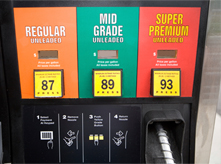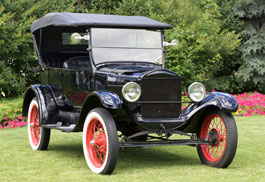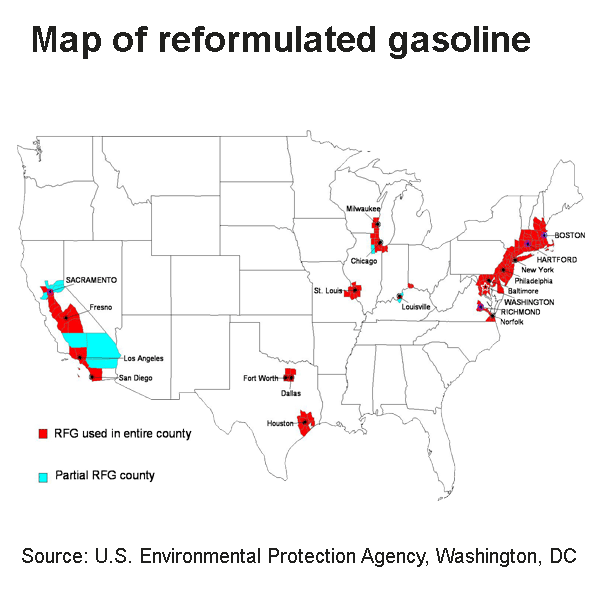Gasoline basics
Gasoline—a petroleum product
Gasoline is a fuel made from crude oil and other petroleum liquids. Gasoline is mainly used as an engine fuel in vehicles. Petroleum refineries and blending facilities produce motor gasoline for sale at retail gasoline fueling stations.
Most of the gasoline that petroleum refineries produce is actually unfinished gasoline (or gasoline blendstocks). Gasoline blendstocks require blending with other liquids to make finished motor gasoline, which meets the basic requirements for fuel that is suitable for use in spark ignition engines.
Gasoline varies by grade

Source: Stock photography (copyrighted)
Three main grades of gasoline are sold at retail gasoline refueling stations:
- Regular
- Midgrade
- Premium
Some companies have different names for these grades of gasoline, such as unleaded (often used for regular-grade), super, or super premium, but they all indicate the octane rating, which reflects the antiknock properties of gasoline. Higher octane ratings result in higher prices. All motor gasoline sold in the U.S. is unleaded. Before 1996, lead was added to gasoline as a lubricant to reduce wear on engine valves. Leaded gasoline was completely phased out of the U.S. motor gasoline fuel system by 1996. Vehicle manufacturers recommend the grade of gasoline for use in each model of a vehicle.
The retail price of gasoline includes four main components:
- The cost of crude oil
- Refining costs and profits
- Distribution and marketing costs and profits
- Taxes
Learn more in What determines gasoline prices? (video).
Uses of gasoline
Gasoline is the primary U.S. transportation fuel
In 2022, Americans used about 3,215,613,000 barrels (or about 135 billion gallons) of finished motor gasoline and about 4,419,000 barrels (or aout 0.19 billion gallons of finished aviation gasoline. Motor gasoline is one of the most consumed fuels in the United States and the main product that U.S. oil refineries produce. Most of the finished motor gasoline sold for vehicles in the United States is about 10% fuel ethanol by volume.

Source: Stock photography (copyrighted)
U.S. consumers use gasoline in:
- Cars, sport utility vehicles, light trucks, and motorcycles
- Recreational vehicles and boats
- Small aircraft
- Equipment and tools used in construction, farming, forestry, and landscaping
- Electricity generators for portable and emergency power supply
In 2022, total gasoline consumption, based on energy content (in British thermal units), accounted for about 57% of total transportation energy consumption, and based on volume (in barrels), 45% of total petroleum consumption.1
Light-duty vehicles (cars, sport utility vehicles, and small trucks) account for about 91% of all gasoline consumption in the United States.2
1 Total gasoline includes finished aviation gasoline and finished motor gasoline including fuel ethanol.
2 Estimates from the Annual Energy Outlook 2023, Reference case, Table 36, February 2022.
History of gasoline
Gasoline was initially discarded
Edwin Drake dug the first oil well in Pennsylvania in 1859 and distilled the oil to produce kerosene for lighting. Although other petroleum products, including gasoline, were also produced in the distillation process, Drake had no use for the gasoline and other products, so he discarded them. It wasn't until 1892, with the invention of the automobile, that gasoline was recognized as a valuable fuel. By 1920, 9 million vehicles powered by gasoline were on the road, and service stations selling gasoline were opening around the country. Today, gasoline is the fuel for nearly all light-duty vehicles in the United States.

Source: Stock photography (copyrighted)
Gasoline octane and lead levels increased over time
By the 1950s, cars were becoming bigger and faster. Gasoline octane increased, and lead was added to improve engine performance.
Leaded gasoline was eventually taken off the U.S. market
Unleaded gasoline was introduced in the 1970s when health problems from lead became apparent. In the United States, leaded gasoline for use in on-road vehicles was completely phased out as of January 1, 1996. Most other countries have also stopped using leaded gasoline in vehicles. In the United States, retail gasoline is now usually sold in three main grades of gasoline that are based on octane levels: regular, medium, and premium.
Ethanol is added to gasoline
In 2022, about 13.6 billion gallons of ethanol were added to gasoline in the United States. In most areas of the country, retail finished motor gasoline is about 10% ethanol by volume.
Gasoline & the environment
Gasoline use contributes to air pollution
Gasoline is a toxic and highly flammable liquid. The vapors given off when gasoline evaporates and the substances produced when gasoline is burned (carbon monoxide, nitrogen oxides, particulate matter, and unburned hydrocarbons) contribute to air pollution. Burning gasoline also produces carbon dioxide, a greenhouse gas.
Laws like the Clean Air Act reduce environmental effects
Most consumers use gasoline in cars, light trucks, and motorcycles, but they also use it in small aircraft, boats and other watercraft, and landscaping and construction equipment. Some of the environmental laws in the United States focus on reducing pollution from these sources.
Did you know?
Burning a gallon of gasoline (that does not contain ethanol) produces about 19.6 pounds of carbon dioxide.
In 2022, total U.S. carbon dioxide emissions from aviation and motor gasoline combustion were about 1,021 million metric tons, or about 22% of total U.S. energy-related carbon dioxide emissions.
The Clean Air Act (the Act) seeks to reduce air pollution in the United States. Specifically, the Act (first passed in 1970) and its amendments require engines and fuels to produce less air pollution, among other requirements, to reduce air pollution from gasoline use.1 To meet the air pollution reduction goals of the Act, the U.S. Environmental Protection Agency (EPA) took several actions:
- Required emissions control devices and cleaner burning engines
Emissions control devices on passenger vehicles were required beginning in 1976. In the 1990s, the EPA established emissions standards for other types of vehicles and for engines used in gasoline-burning non-road equipment.2 - Removed leaded gasoline for use in vehicles
Lead in gasoline proved to be a public health concern. The move away from leaded gasoline began in 1976 when catalytic converters were installed in new vehicles to reduce the emissions of toxic air pollutants. Vehicles equipped with a catalytic converter cannot operate on leaded gasoline because the presence of lead in the fuel damages the catalytic converter. Leaded gasoline for use in vehicles was completely phased out of the U.S. fuel system by 1996. Leaded aviation gasoline is allowed for use in piston-engine aircraft. The U.S. government is supporting research on alternative, lead-free fuels for those types of aircraft.3 - Required the use of reformulated gasoline
Beginning in 1995, the Clean Air Act Amendments of 1990 required cleaner burning reformulated gasoline to reduce air pollution in metropolitan areas that had significant ground-level ozone pollution. - Required the supply of ultra-low sulfur gasoline
As of January 1, 2017, refiners are required to supply gasoline with 97% less sulfur content than the gasoline made in 2004. Gasoline with lower sulfur content reduces emissions from old and new vehicles and is necessary for advanced vehicle emission control devices to work properly. - Reduced the risk of gasoline leaks
Gasoline leaks happen at gas stations every day. As people fill up their gas tanks, gasoline drips from the nozzle onto the ground and vapors leak from the open gas tank into the air. Gasoline leaks can also happen in pipelines or in underground storage tanks where they can't be seen.4 Beginning in 1990, all underground storage tanks had to be replaced by tanks with double lining. The double lining provides an additional safeguard for preventing leaks.
Methyl tertiary butyl ether (MTBE), one of the chemicals added to gasoline to help it burn cleaner, is toxic, and a number of states started banning the use of MTBE in gasoline in the late 1990s. By 2007, the U.S. refining industry had voluntarily stopped using MTBE when making reformulated gasoline for sale in the United States. MTBE was replaced with ethanol, which is not toxic.
1 U.S. Environmental Protection Agency, Transportation: Mobile Sources.
2 U.S. Environmental Protection Agency, Nonroad Engines, Equipment, and Vehicles.
3U.S. Federal Aviation Administration, Aviation gasoline.
4 U.S. Environmental Protection Agency, Underground Storage Tanks.



